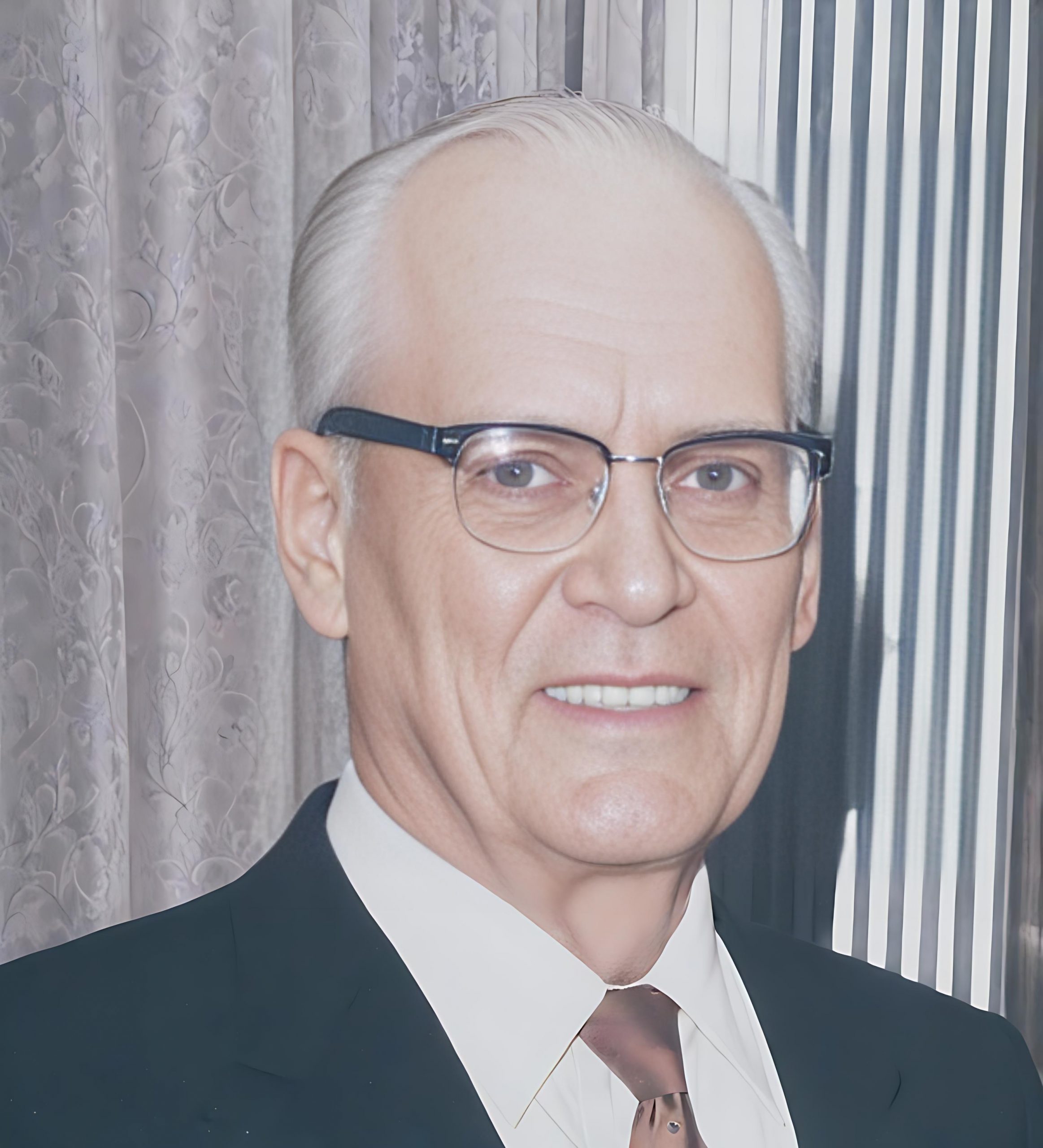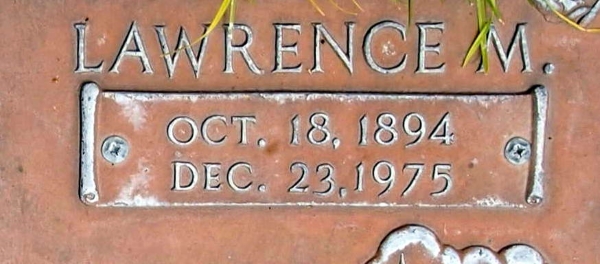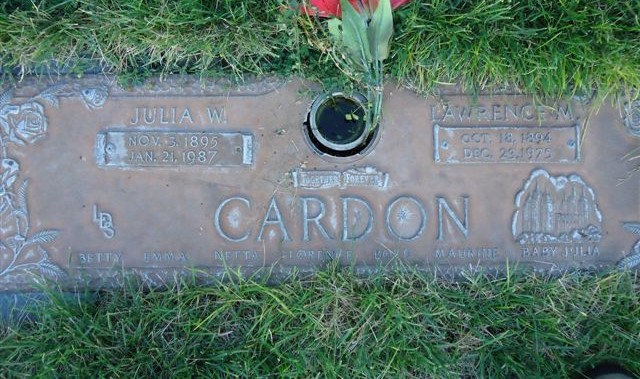18 Oct 1894 – 23 Dec 1975
Great-Grandson of Philip Cardon and Martha Marie Tourn
Grandson of John (Jean) Cardon and Anna Regula Furrer
Son of John David Cardon and Elizabeth Nesser
History of Lawrence Marion Cardon
Contributed by Michael L Cardon
Lawrence was born October18, 1894 in Ogden, Utah. He was the son of John David and Elizabeth Neeser Cardon. He was the 7th child of 13 children and 8 living brothers and sisters. As a youngster, Lawrence had snow-white hair and his mother said if he wandered among a herd of sheep, she would have a time finding him. When he was in the fifth grade he contracted Brights disease (inflammation of the kidney). After some time the doctors were not getting him any better. He hadn’t eaten in some time. The Elders were called in and after he was given a blessing, he immediately got up and found a piece of bread and started to eat it. He steadily got better. This was considered a medical miracle to the doctors. It had been two years before he was able to go back to school. He was determined to be in the same grade as his friends of his age. But the teachers insisted he go back two grades with his brother, Herman. Lawrence started to leave the school when the teachers ran after him to bring him back. He paid no attention to their calls and refused to go to school again.
The family decided to homestead at Black Pine in Idaho and the age of sixteen he walked all the way, driving the cattle from Ogden to Black Pine. All there was to live in at that time was a dugout or a hole dug in the side of a hill. They hauled water in barrels and pumped water from them. The freeway (I-15) now runs through the farm. He spent the years here helping on the farm: growing wheat and hauling it to Kelton in horse-drawn wagons. The wheat was delivered to Kelton as that was the only market. They attended church in Juniper. He would go up on the Black Pine Mountain and cut down cedars to sell for posts, which he loaded high on his wagon gear and hauled them with horses to Ogden to sell. He acquired a spirited saddle horse and had a fancy cowboy hat and chaps. His first love was Percy Monday, whom he went with for years. She went out with another boy to make Lawrence jealous….He never had another thing to do with her, even her folks tried to help her win him back. He had his feelings hurt. She was to be an heiress and in later years Lawrence spoke of her often.
Looking for work Lawrence rode over the mountain to Curlew Valley and inquired where the Wheelers were putting up hay. Julia Wheeler had the job of bringing lunches in the wagon to the field. Her brother Andrew said to Lawrence, “That’s my sister. Don’t tell her I said so, but she is 19 years old.” Lawrence was then 21 years old and often told how he was impressed with her politeness and they began dating.
He took her to see his mother who encouraged them to get married right away as Lawrence was draft age and a single man and like most mothers she didn’t want him to go off to World War I. They went home to Julia’s place and she began making her wedding dress. Her father gave his consent even though her mother was in Ogden getting peaches. October 13, 1917 they rushed off to Malad, Idaho to get married. (Lawrence joked all his life about how the wedding dress had a pin that would stick him whenever he would hug her.) After the wedding Julia was left at the hotel room while Lawrence got his haircut and the horse’s feet shod. He was gone long enough for her to not only worry about where he was but to wonder how upset her mother might be about losing her only daughter. When they returned home her mother had already returned from Utah with the wagonload of fruit. In those days, all fruit had to be bottled for the coming year and it was a big job. The wedding came as a complete surprise and she didn’t take losing her only daughter very well because she had all that work to do. Lawrence, seeing the situation, went home for a week, while Julia helped her mother with this job. Lawrence’s older brother, Earnest, told him he was not needed anymore because he had bought the deed to the ranch, so he wouldn’t have to go into the army since he was a farm owner.
They went to Black Pine that winter and stayed until February. They went to Curlew and hooked up the horses to a sleigh and went to Utah. They were sealed to each other in the Temple 3 February 1918. Lawrence and Julia’s first home was a homestead on top of the divide between Curlew and Juniper, Idaho. Betty, their first child was born April 22, 1919. They had to make the trip by buggy to Ogden, as it was time for the baby to be born. It had been flooding. They were almost swept away going over the bridge at Blue Creek. Julia walked over what was left of the bridge while Lawrence forged the stream with the team and wagon. They were able to get there safely before the baby was born. Julia stayed with the new baby until July and then Lawrence came and got her. They went back to Juniper to the new home Lawrence was building. They had a wagon that they filled with barrels and a team of horses to dry farm with. The spring of 1920 Lawrence got pneumonia. Julia put branches across the road with a rock on top of a note asking for help. Abe Clark found the note and gave it to his mother; she went to help them, as they were isolated. Mr. Clark related this story to their daughter Netta some fifty years later. He was a teenaged boy at the time it happened. Before Betty was two years they had their cabin about half-done. About that time, Lawrence didn’t recognize a sievic cat as a skunk and tried to catch the pretty thing. It sprayed the house so they were forced to leave this home and from there they all went to live near Inkom, Idaho on Marsh Creek, where the rest of the Cardon family were farming.
Lawrence went to Marsh Creek in 1920 and Ernest came back to get horses and stock and Betty and Julia. Soon after they dissolved their partnership. Grandpa and Grandma Cardon became discouraged there among the lava and returned to Ogden to their original homestead. Ernest went to Warren, Utah and Roy settled in Inkom. Lawrence and Julia rented a farm in the hills near upper Walker Creek and grew some beautiful wheat, which a man promised to thresh right away. But by the time he got there, the rain had ruined the crop. Still good things did happen during those times. Julia went to Ogden alone this time since Lawrence was so busy and Emma was born, June 9, 1921. They moved to another bigger and better farm bordered by Walker Creek on one side and Marsh Creek at the end. Netta was born December 2, 1923, also at Ogden, Utah. Their next move was to an irrigated farm on Marsh Creek, five miles from McCammon. They raised cattle and hay and milked cows. Florence was born here at home on May 29, 1925. Lawrence now had four little girls. In July of 1927, Julia had a baby girl who was stillborn. The family was devastated, but there were good times too. The children enjoyed playing among the trees and streams and Betty, Emma and Netta had a horse to ride to school. They acquired a Model T Ford and a phonograph. Every time Lawrence went to Pocatello he would bring back a new record. Everyone learned all the words of each song because they were played so much. Lawrence loved the song, “Lucky Lindy Flies All Alone” and he would sing it as he worked. He had a good voice. The place they were farming was rented and it was sold without any warning, so they had to look for another farm.
From McCammon they moved to Oxford, Idaho. Betty was only eight years old when she helped her Dad herd the cattle on horseback to Oxford. This was the first time they had lived close in a community. They built a large chicken house and sold eggs, milked cows and put up hay. The children were close to school and church. Lawrence was Ward Clerk for many years. He was also in the Bishopric. Boyd was born at Downey, Idaho on June 7, 1929. Maurine was born at home in Oxford on November 29, 1932. It was during the depression and the weather was especially dry. One year they took their eggs to Preston, Idaho which was 20 miles away with a team and wagon, but didn’t get hardly anything for them. Finally the streams dried up, as there was no snow in the mountains that year and the town suffered. Roosevelt became president and made it possible to get out from under debt and we were able to sell our farm for $500.00.
In 1933 they were able to rent an unimproved farm in Trenton, Utah. The neighbors said that no water could run out on this farm but Lawrence was ingenious and built an enormous ditch and in came the water where it had never been before. With this success the land was put up for sale. They had no money until the Lord intervened. Frank Tosten, who had refused to pay the balance he owed for the farm by March Creek, needed a clear title and showed up in Trenton with the one thousand dollars he owed. Lawrence was able to make a down payment on the farm. Part of the time the kids lived in a tent and washed diapers in the big ditch. It also was a place where the children could learn to swim. We had lots of carp and suckers (fish) from the bottomland where Bear River flowed. The depression got over for everyone and times were better. The girls thinned and hoed sugar beets and Maurine and Boyd herded cows to save on feed. Lawrence drove new cars and was able to build a new, four-bedroom house and a new milk barn. He was active in the LDS church. He was a director in the West Cache Canal most of the time. The girls dated here and some of their boy friends would milk cows if the girls (Netta and Emma) would go out with them. About this time World War II started. Emma and Betty had married and since their husbands were away serving in the military, the girls stayed at home and helped Lawrence on the farm making it possible to get all the work done. After the war, Milton and Emma had already went to the Burley area to purchase a farm. So Lawrence saw this as an opportunity for the rest of the family to find farmland.
In 1946 they moved to Burley, Idaho in the Springdale Ward, where they purchased a farm from Fred Christerson and later added another eighty acres. Here the last of their children was married. Lawrence and Julia fulfilled a Stake Mission. Lawrence served as director in the Federal Land Bank and was a director for the Challenge Creamery. He had a wonderful herd of registered Holsteins. They sold this farm to Ray Zollinger.
Lawrence and Julia purchased a motor home and spent summers with their son, Boyd, who was farming at Grandview and Prosser, Washington. Winters were spent in Mesa, Arizona, busy doing temple work. They had a lot of friends there and loved to travel. They had purchased the home in Declo, Idaho from Netta. They helped Floyd and Florence on their farm and the grandchildren enjoyed them. They also enjoyed going to church in Declo. Lawrence worked as long as he could get around, planting trees and they always had lots of flowers and a garden of vegetables. Lawrence had a testimony of the gospel, which he bore in church regularly. He was proud of his Swiss and Piedmont heritage.
One day in November 1972 he had a stroke which left him paralyzed in all but his left arm. He also couldn’t speak. He was first taken to the hospital and we hoped he could recover, which was not the case. They then moved him to the geriatrics ward where conditions were terrible. After about three days, Julia said, “I want to take him home.” The nurse remarked that she would soon have him back. Julia was a wonderful nurse for three years. Sometimes we would find them on the floor. He could use only one arm to help her get him from his bed to his chair. When he left the hospital he had already developed many bedsores which she soon got rid of. He never got so that he could talk but he could sing a little of In My Lovely Deseret.
His favorite hymn. He passed away in the Cassia Memorial Hospital December 23, 1975. He was buried in Gem Memorial Gardens in Burley, Idaho. It was fitting that he was buried where there are beautiful trees. After his death, Florence relates how she was asked for his certificate to his ordination to an Elder in the church because the church records failed to have it. It seemed impossible to locate; thinking it must have been lost in all the moves. This must have been really important. It was like a miracle because in the mail there was the certificate. While going through some papers in the old Ogden home it had been located. This was a testimony that father had truly gone home to our Heavenly Father.

Lawrence Marion Cardon, 81-year-old Declo resident, died Tuesday in the Cassia Memorial Hospital following a brief illness.
He was born Oct. 18, 1894, in Ogden, Utah, the son of John David and Elizabeth Nesser Cardon. He married Julia May Wheeler Oct. 13, 1917, in Malad. The marriage was solemnized in the Salt Lake LDS Temple on Feb. 5, 1918. He was a High Priest in the LDS Church. He was active in the MIA and in Boy Scout work. He had served as ward clerk, bishop’s counselor and Stake Missionary. After his retirement he spent many working in the Arizona LDS Temple. He had served as director of the Jerome Cooperative Creamery and the Federal Land Bank.
Survivors include his widow of Declo; five daughters, Mrs. Cling (Betty) Cook, Mesa Ariz.; Mrs. Milton (Emma) Payne, Burley; Mrs. Glen (Netta) Baum, Twin Falls; Mrs. Floyd (Florence) West and Mrs. Maurine Gillette both Declo; one son Boyd Cardon, Grandview, Wash.; one sister, Mrs. Clarence Coray, Ogden, Utah; 29 grandchildren and 23 great-grandchildren. He was preceded in death by his parents, 11 brothers and sisters, one daughter, one granddaughter and one great-grandson.
Funeral services will be conducted Saturday at 10 a.m. at the Declo LDS Chapel with Bishop Leo Hurst officiating. Interment will be in the Gem Memorial Gardens in Burley.
Friends may call at the Payne Chapel Friday afternoon and evening and at the place of services one hour prior to the funeral on Saturday.
-Published in the South Idaho Press (Burley, Idaho), Wednesday, December 24, 1975, Page 2
Gem Memorial Gardens, Burley, Cassia County, Idaho, Plot: Rainbow L Block 13 Space 1


